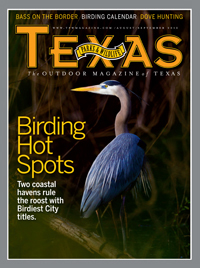
Wild Thing: The Color of Hummers
Buff-colored bellies distinguish this lesser-seen hummingbird.
By Mark Klym
The garden was alive with sound as the research team assembled the traps and equipment. Bees hustled from flower to flower, harvesting nectar. In the trees nearby, squirrels chattered while cardinals worked the feeders. Ruby-throated hummingbirds, the team’s primary target, zipped boldly around the blossoms.
Suddenly, a staccato chorus of tchik, tchik, tchik exploded from nearby brush, and an impressive emerald hummingbird emerged.
Once limited to the South Texas plains, the buff-bellied hummingbird is found in Central and East Texas more frequently. Homes in Bastrop County have reported two to three individuals year-round for several years, and there are known nests in Victoria and DeWitt counties. Winter finds this bird all along the Texas coast and the Rio Grande Valley, with some even visiting Louisiana and Alabama gardens.

Buff-bellied hummingbird.
Buff-bellied hummingbirds can be found in Texas year-round, although they are more likely to be observed March through October. Migrating birds arrive first in the Rio Grande Valley and along the coast, and Central Texans should look for them in late spring and summer.
Buff-bellied hummingbirds are slightly larger than the common ruby-throated or black-chinned hummingbirds, with a deep emerald-green head and upper body. The iridescent blue-green of the throat and upper breast are revealed in bright sunlight. The wings, tail and rump are cinnamon red, while the belly area is a buff color, from which the bird draws its name.
Open forests are generally the habitat of buff-bellied hummingbirds, although they can be found in brush or in home gardens. Consistent elements of their habitats include trees, brush and available water. Females will nest in short trees and tall brush, preferring plants with thorns to protect the eggs and young.
Plants are the foundation of any hummingbird habitat. The Turk’s cap and sages (salvia species) usually found in a hummingbird garden are great choices for the buff-bellied hummingbird, but the birds are also noted for using some unusual species, including huisache and Texas wild olive.
Not surprisingly, hummingbirds can be observed most easily in gardens designed to attract them. Many southeastern Texas parks offer good opportunities. Along the Rio Grande Valley, Quinta Mazatlan, Frontera Audubon, Estero Llano Grande, Valley Nature Center and the World Birding Center in Edinburg are all reliable locations.
On the upper coast, the Gulf Coast Bird Observatory often has a buff-bellied hummingbird or two in the winter. During the summer months, McKinney Roughs Nature Center near Bastrop has been host to this beautiful bird.
Related stories
See more wildlife articles on the TP&W Wildlife page

